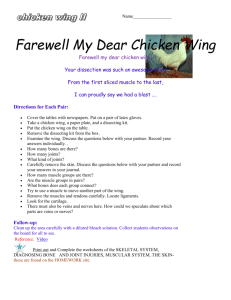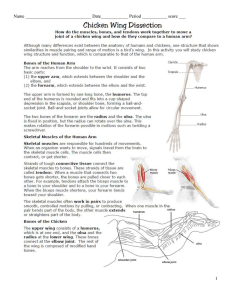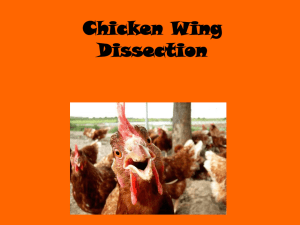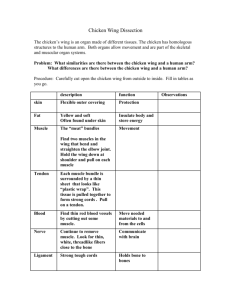Chicken Wing Anatomy Lab: Dissection Guide
advertisement
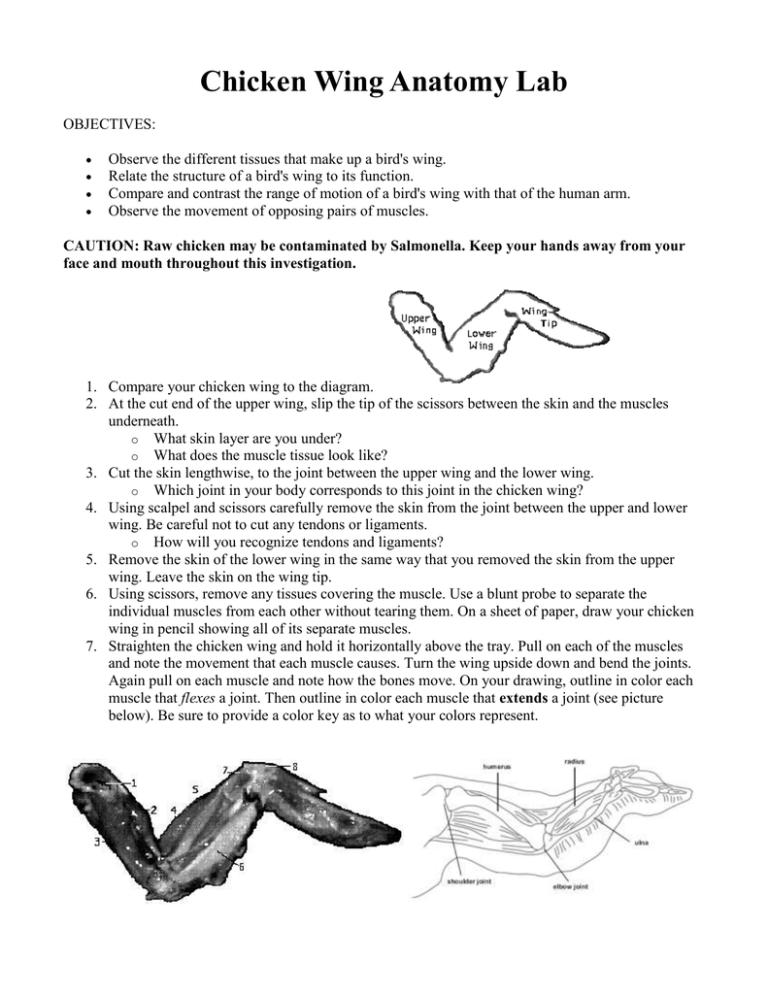
Chicken Wing Anatomy Lab OBJECTIVES: Observe the different tissues that make up a bird's wing. Relate the structure of a bird's wing to its function. Compare and contrast the range of motion of a bird's wing with that of the human arm. Observe the movement of opposing pairs of muscles. CAUTION: Raw chicken may be contaminated by Salmonella. Keep your hands away from your face and mouth throughout this investigation. 1. Compare your chicken wing to the diagram. 2. At the cut end of the upper wing, slip the tip of the scissors between the skin and the muscles underneath. o What skin layer are you under? o What does the muscle tissue look like? 3. Cut the skin lengthwise, to the joint between the upper wing and the lower wing. o Which joint in your body corresponds to this joint in the chicken wing? 4. Using scalpel and scissors carefully remove the skin from the joint between the upper and lower wing. Be careful not to cut any tendons or ligaments. o How will you recognize tendons and ligaments? 5. Remove the skin of the lower wing in the same way that you removed the skin from the upper wing. Leave the skin on the wing tip. 6. Using scissors, remove any tissues covering the muscle. Use a blunt probe to separate the individual muscles from each other without tearing them. On a sheet of paper, draw your chicken wing in pencil showing all of its separate muscles. 7. Straighten the chicken wing and hold it horizontally above the tray. Pull on each of the muscles and note the movement that each muscle causes. Turn the wing upside down and bend the joints. Again pull on each muscle and note how the bones move. On your drawing, outline in color each muscle that flexes a joint. Then outline in color each muscle that extends a joint (see picture below). Be sure to provide a color key as to what your colors represent. 8. Find as many tendons as possible in your chicken wing. Determine where each tendon connects to a bone. Outline in color, the tendons in your drawing. 9. Cut through the middle of a muscle that you have identified as a flexor for the upper wing. o What happens to the wing? 10. Cut through the middle of a muscle that you have identified as an extensor for the lower wing. o What happens to the wing? 11. Closely examine the joint between the upper wing and the lower wing and identify the ligaments. Using a purple pencil, add ligaments to your drawing. 12. Bend and straighten the joint and observe how the bones fit together. The shiny, white covering of the joint surfaces is made of cartilage. o What is the purpose of this cartilage? 13. Find and describe to your partner the following structures: Blood, blood vessels, cartilage, joints, tendons, ligaments, skin, feathers (follicle derivations), bones (ulna, radius, hummers, metacarpals, & phalanges), muscles (biceps & triceps), nerves, and adipose tissue (fat). ***Note – your will have a lab practicum quiz on Friday. Be able to identify and/or describe every structure listed in item #13. *On your separate diagram sheet - Answer these final questions and turn in your lab sheet to be graded. 1. What function is performed by ligaments? __________________________________________________ What is the function of a tendon? _______________________________________________________ 2. What is more proximal, the insertion or the origin for the attachment of the muscles in the chicken wing? 3. What tissue is referred to when one speaks of the “meat” of the chicken? _________________________ 4. Name the two main types of movement that occur when a wing is raised and lowered in flight. ____________________________________________________________________________________________ 5. What bone in the wing is connected to the chicken’s body at the shoulder? _______________________ 6. Name the two bones found in the forearm of the wing. ________________ _______________________ 7. What type of joint connects the wing to the body? ___________________________________________ 8. What type of joint moves the wing at the elbow? _____________________________________________ 9. The muscle you observed is classified as what type of muscle tissue? ______________________________ 10. What part of your body corresponds (is homologous) to the wing of a chicken? _______________________ *Reference: The Wing and I by Jim Edstrom JimEkstrom/index.php http://www.accessexcellence.org/AE/ATG/data/released/0498-
